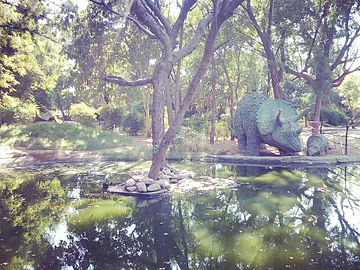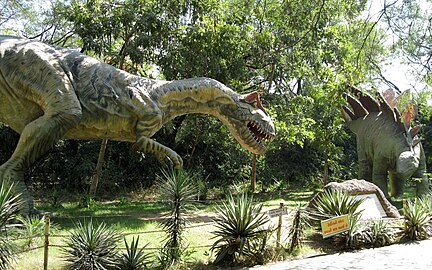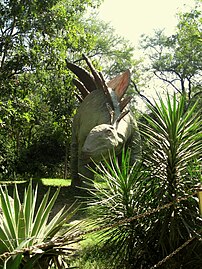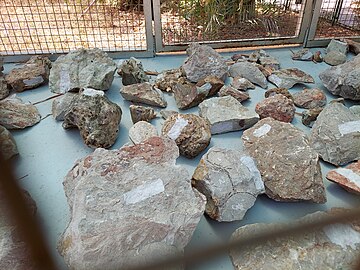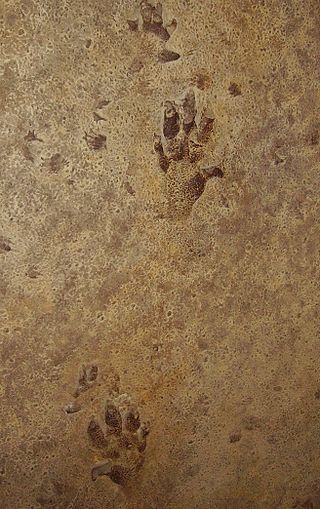
A trace fossil, also known as an ichnofossil, is a fossil record of biological activity by lifeforms but not the preserved remains of the organism itself. Trace fossils contrast with body fossils, which are the fossilized remains of parts of organisms' bodies, usually altered by later chemical activity or mineralization. The study of such trace fossils is ichnology and is the work of ichnologists.

Bruhathkayosaurus is a potentially dubious genus of sauropod dinosaur found in the Kallamedu Formation of India. The fragmentary remains were originally described as a theropod, but it was later determined to be a titanosaurian sauropod. Length estimates by researchers exceed those of the titanosaur Argentinosaurus, as longer than 35 metres (115 ft) and weighing over 80 tonnes. A 2023 estimate placed Bruhathkayosaurus as potentially weighing approximately 110–170 tonnes. If the upper estimates of the 2023 records are accurate, Bruhathkayosaurus may have rivalled the blue whale as one of the largest animals to ever exist. However, all of the estimates are based on the dimensions of the fossils described in Yadagiri and Ayyasami (1987), and in 2017, it was reported that the holotype fossils had disintegrated and no longer exist.

The Morrison Formation is a distinctive sequence of Upper Jurassic sedimentary rock found in the western United States which has been the most fertile source of dinosaur fossils in North America. It is composed of mudstone, sandstone, siltstone, and limestone and is light gray, greenish gray, or red. Most of the fossils occur in the green siltstone beds and lower sandstones, relics of the rivers and floodplains of the Jurassic period.

Torvosaurus is a genus of large megalosaurine theropod dinosaur that lived approximately 165 to 148 million years ago during the Callovian to Tithonian ages of the late Middle and Late Jurassic period in what is now Colorado, Portugal, Germany, and possibly England, Spain, Tanzania, and Uruguay. It contains two currently recognized species, Torvosaurus tanneri and Torvosaurus gurneyi, plus a third unnamed species from Germany.

Rajasaurus is a genus of carnivorous abelisaurid theropod dinosaur from the Late Cretaceous of India, containing one species: Rajasaurus narmadensis. The bones were excavated from the Lameta Formation in the Gujarat state of Western India, probably inhabiting what is now the Narmada River Valley. It was formally described by palaeontologist Jeffrey A. Wilson and colleagues in 2003 based on a partial skeleton comprising the braincase, spine, hip bone, legs, and tail–a first for an Indian theropod. The dinosaur likely measured 6.6 metres (22 ft), and had a single horn on the forehead which was probably used for display and head-butting. Like other abelisaurids, Rajasaurus was probably an ambush predator.

Dryosaurus is a genus of an ornithopod dinosaur that lived in the Late Jurassic period. It was an iguanodont. Fossils have been found in the western United States and were first discovered in the late 19th century. Valdosaurus canaliculatus and Dysalotosaurus lettowvorbecki were both formerly considered to represent species of Dryosaurus.

Size is an important aspect of dinosaur paleontology, of interest to both the general public and professional scientists. Dinosaurs show some of the most extreme variations in size of any land animal group, ranging from tiny hummingbirds, which can weigh as little as two grams, to the extinct titanosaurs, which could weigh as much as 50–100 t.

A fossil track or ichnite is a fossilized footprint. This is a type of trace fossil. A fossil trackway is a sequence of fossil tracks left by a single organism. Over the years, many ichnites have been found, around the world, giving important clues about the behaviour of the animals that made them. For instance, multiple ichnites of a single species, close together, suggest 'herd' or 'pack' behaviour of that species.
The Geological Survey of India (GSI) currently maintains two protected areas bearing rich fossil deposits.

Dinosaur eggs are the organic vessels in which a dinosaur embryo develops. When the first scientifically documented remains of non-avian dinosaurs were being described in England during the 1820s, it was presumed that dinosaurs had laid eggs because they were reptiles. In 1859, the first scientifically documented dinosaur egg fossils were discovered in France by Jean-Jacques Poech, although they were mistaken for giant bird eggs.

Dinosaur Ridge is a segment of the Dakota Hogback in the Morrison Fossil Area National Natural Landmark located in Jefferson County, Colorado, near the town of Morrison and just west of Denver.
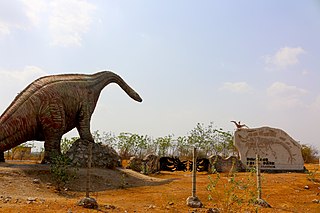
Balasinor, also known as Vadasinor, is a city located in the Mahisagar district of Gujarat, India. The city was formerly part of Balasinor State, a princely state ruled by the Babi dynasty, from September 1758 until its accession to India in June 1948.
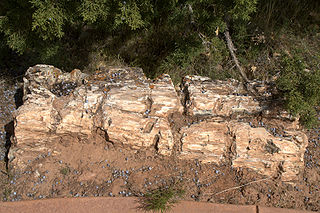
Escalante Petrified Forest State Park is a state park of Utah, USA, located a half-mile (0.8 km) north of the town of Escalante. A visitor center was built in 1991, and features displays of plant and marine fossils, petrified wood and fossilized dinosaur bones over 150 million years old. The Petrified Forest Trail is a one-mile (1.6 km) loop, winding up the side of a mesa to the top where most of the fossil wood occurs. Logs two feet or more in diameter are seen at several places along the trail where it is eroding from the conglomerate capping the mesa. This conglomerate lies near the top of the Brushy Basin Member of the Morrison Formation. The wood is multicolored and was prized by hobbyists before the Park was established. The logs are believed to be of conifers that were transported by a river before being buried and later fossilized as agate. A 50 foot (15m) log is displayed near the trail head and is one of the most complete fossil logs known from the Morrison Formation.

Paleontology in Colorado refers to paleontological research occurring within or conducted by people from the U.S. state of Colorado. The geologic column of Colorado spans about one third of Earth's history. Fossils can be found almost everywhere in the state but are not evenly distributed among all the ages of the state's rocks. During the early Paleozoic, Colorado was covered by a warm shallow sea that would come to be home to creatures like brachiopods, conodonts, ostracoderms, sharks and trilobites. This sea withdrew from the state between the Silurian and early Devonian leaving a gap in the local rock record. It returned during the Carboniferous. Areas of the state not submerged were richly vegetated and inhabited by amphibians that left behind footprints that would later fossilize. During the Permian, the sea withdrew and alluvial fans and sand dunes spread across the state. Many trace fossils are known from these deposits.

Paleontology in Utah refers to paleontological research occurring within or conducted by people from the U.S. state of Utah. Utah has a rich fossil record spanning almost all of the geologic column. During the Precambrian, the area of northeastern Utah now occupied by the Uinta Mountains was a shallow sea which was home to simple microorganisms. During the early Paleozoic Utah was still largely covered in seawater. The state's Paleozoic seas would come to be home to creatures like brachiopods, fishes, and trilobites. During the Permian the state came to resemble the Sahara desert and was home to amphibians, early relatives of mammals, and reptiles. During the Triassic about half of the state was covered by a sea home to creatures like the cephalopod Meekoceras, while dinosaurs whose footprints would later fossilize roamed the forests on land. Sand dunes returned during the Early Jurassic. During the Cretaceous the state was covered by the sea for the last time. The sea gave way to a complex of lakes during the Cenozoic era. Later, these lakes dissipated and the state was home to short-faced bears, bison, musk oxen, saber teeth, and giant ground sloths. Local Native Americans devised myths to explain fossils. Formally trained scientists have been aware of local fossils since at least the late 19th century. Major local finds include the bonebeds of Dinosaur National Monument. The Jurassic dinosaur Allosaurus fragilis is the Utah state fossil.

Egg fossils are the fossilized remains of eggs laid by ancient animals. As evidence of the physiological processes of an animal, egg fossils are considered a type of trace fossil. Under rare circumstances a fossil egg may preserve the remains of the once-developing embryo inside, in which case it also contains body fossils. A wide variety of different animal groups laid eggs that are now preserved in the fossil record beginning in the Paleozoic. Examples include invertebrates like ammonoids as well as vertebrates like fishes, possible amphibians, and reptiles. The latter group includes the many dinosaur eggs that have been recovered from Mesozoic strata. Since the organism responsible for laying any given egg fossil is frequently unknown, scientists classify eggs using a parallel system of taxonomy separate from but modeled after the Linnaean system. This "parataxonomy" is called veterovata.

This timeline of egg fossils research is a chronologically ordered list of important discoveries, controversies of interpretation, taxonomic revisions, and cultural portrayals of egg fossils. Humans have encountered egg fossils for thousands of years. In Stone Age Mongolia, local peoples fashioned fossil dinosaur eggshell into jewelry. In the Americas, fossil eggs may have inspired Navajo creation myths about the human theft of a primordial water monster's egg. Nevertheless, the scientific study of fossil eggs began much later. As reptiles, dinosaurs were presumed to have laid eggs from the 1820s on, when their first scientifically documented remains were being described in England. In 1859, the first scientifically documented dinosaur egg fossils were discovered in southern France by a Catholic priest and amateur naturalist named Father Jean-Jacques Poech, however he thought they were laid by giant birds.
Reptile egg fossils are the fossilized remains of eggs laid by reptiles. The fossil record of reptile eggs goes back at least as far as the Early Permian. However, since the earliest reptile eggs probably had soft shells with little preservation potential, reptilian eggs may go back significantly farther than their fossil record. Many ancient reptile groups are known from egg fossils including crocodilians, dinosaurs, and turtles. Some ancient reptiles are known to have given live birth and are therefore not anticipated to have left behind egg fossils.

Wasson Bluff is the name applied to a series of imposing cliff faces on the north shore of the Minas Basin about 5 miles (8.0 km) east of the town of Parrsboro, Nova Scotia. The cliffs, which stretch approximately one mile (1.6 km) from Wasson Brook in the east, to Swan Creek in the west, consist of 200-million-year-old rocks that have yielded a wide array of fossils including more than 100,000 bones from Canada's oldest-known dinosaurs as well as the smallest dinosaur tracks ever found. The fossils date from a critical time in the evolution of life, the boundary between the Triassic and Jurassic geological periods, when mass extinctions led not only to the dominance of the dinosaurs, but also to the evolution of groups of vertebrates, such as fish, crocodiles, frogs and mammals, whose descendants are still alive today. The abrasive action of the tides, considered to be the world's highest, constantly exposes fossils on the cliff faces, shores and seabed.


